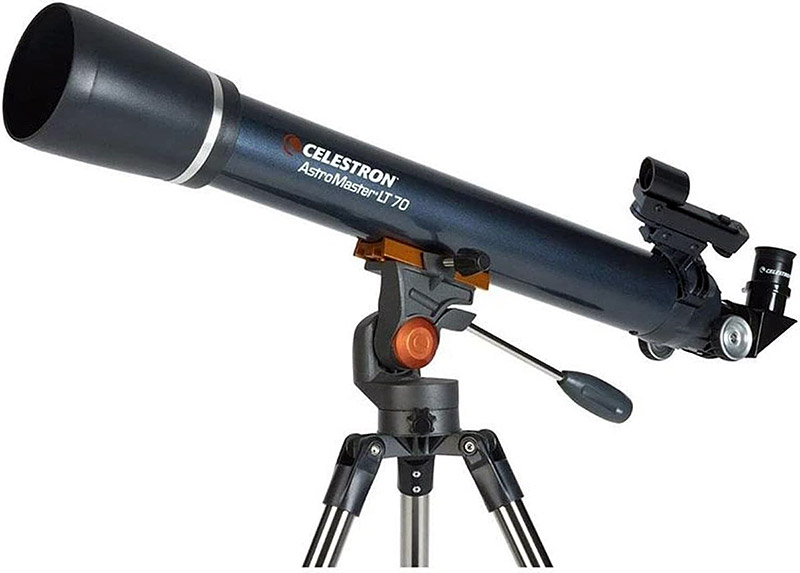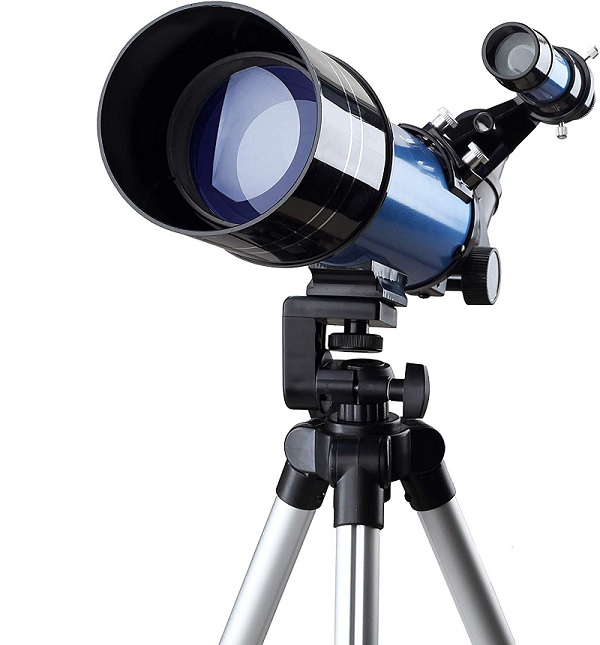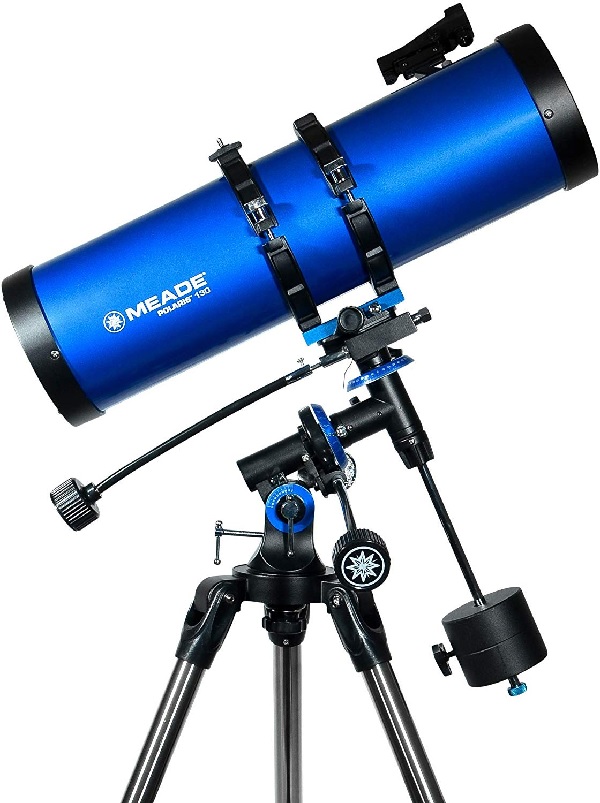Updated for 2022-2023
It is usually around the ages of 10 to 12 when kids can start to develop interest and curiosity about space. They are really getting to experience the world and question everything in and out of it, which makes it a perfect age to introduce them to astronomy and other sciences.
There are a few considerations a parent should have when shopping for a telescope for kids in this age range. The good news is we have done all the research and heavy work for you and we have prepared this guide with our best picks in order to make the whole process very easy for you. We will cover options that will be best for the age range of 10 to 14. If you just want to skip to the finish line, our best pick is below, if you are looking for more information and options, keep reading.
Best Pick: Celestron StarSense 80AZ

| Manufacturer | Celestron |
| Telescope type | Refractor |
| Aperture | 80mm (3.14″) |
| Focal Length | 900mm |
| Max. Useful Magnification | 189x |
| Max. Limiting Magnitude | 12.1 |
| Mount | Equatorial |
| Weight | 9.2 lbs (4.1 kg) |
| Bundled eyepieces | 10mm, 20mm, 2x Barlow |
| Rating | |
| Price |
The StarSense technology that is found in some Celestron telescopes is amazing for kids. It removes a lot of the learning curve and frustrating parts about learning to use a telescope and makes the experience much more friendly and enjoyable.
Here’s how it works.
The tube of the StarSense telescopes have a smartphone adapter. Once you have set the phone, fire up the included app and follow the instructions that will ask you to line up three stars or the Moon. The app will then automatically map out the sky for your location and the date and will show you on the screen the names of the things you are looking at.
If you want to find a specific star, constellation, planet, or galaxy, you can search for it on the database. The app will point you to the correct location so you can quickly enjoy the view.
This removes one of the main difficulties of getting started with a telescope which is finding the objects that you want to look at. Learning to star-hop or figuring out latitudes and longitudes is not fun at all, especially for a kid. The StarSense telescopes completely solve this problem.
As for the rest of the telescope, it is very similar in quality to the AstroMaster line of telescopes by the same company which have very solid optics and great build quality.
Power: With an aperture of 3.14 inches (80mm), the StarSense LT 80AZ should be powerful enough to explore the planets in our Solar System up to Saturn. Neptune and Uranus can be observed under excellent sky conditions but they’ll only look like blue dots. It will also be able to clearly see all the constellations and some of the brighter galaxies and nebulae.
Expandability: This telescope is powerful enough to serve for many years before the user will feel the need to upgrade to something more sophisticated. At some point, you might want to upgrade the included eyepieces and Barlow lens to improve the image. Fortunately, since the barrel of eyepieces is standard in size (1.25″), these can be used for your next telescope. Here are some zoom eyepiece recommendations which are great to start forming a collection on a budget.
Alternatives: There’s a 102mm version of this telescope that offers a larger aperture and a slightly better mount. The jump in price is a little bit too steep for my taste but if you want more power and you have the budget it is also a great choice.
Table of Contents
- How we selected the telescopes on this list
- What owning a telescope will teach a 10-year-old
- Best budget pick
- Best tabletop
- Best mid-range pick
- Best high-end
- Best choice
How we selected the telescopes on this list
We have decades of combined experience looking at the stars and helping newcomers get into our favorite hobby: astronomy.
The criteria we used to choose the telescopes on this list is based on what features make the most sense for kids in the 10-14 age range and where their level of understanding about space is at the time. Here’s what we think are the most important characteristics to look for.
It must be easy to use and set up.
We are looking for kids to enjoy astronomy. The process to set up and look at the sky with their first or second telescope should be simple and fun.
For this reason, the list will mostly include scopes that are easy to use while still having an available learning curve with more advanced features that will be waiting for when they are more familiarized with the device.
Low maintenance
Since the idea is kids at this age will already be able to use the telescope by themselves and mostly unsupervised, maintenance becomes a factor. We have stayed away from Newtonian telescopes (with one exception) and focused mostly on refractors since they require less maintenance and are generally sturdier.
Good price to features ratio
Let’s face it. If this is the first time your kid has asked to get them a telescope, you might be worried if it’s just a phase they’ll grow out of and that you will be spending some good money on something that might end up collecting dust in the basement. We get it, we have all been there.
This is why our picks have taken price into account. We have focused on selecting scopes that will offer the best available features for the entry-level range. A professional-grade telescope with all the bells and whistles might not be the best investment at this point. If they do get genuinely interested in the hobby after using one of these choices for a few years, then you can think of upgrading.
Power (a.k.a magnitude)
How “powerful” a telescope is, depends mostly on one single feature: the lens’ magnitude. We have a whole guide on why aperture is important if you want to check it out, but the short version is the higher the aperture, the more light the telescope can capture which allows you to get better images and view objects farther away.
We believe the minimum aperture for a telescope to be enjoyable is around 70mm or about 2.75 inches. Anything below that is usually not worth the money as you will not be able to see much with it.
The telescopes on the list are in the 70mm – 130mm range as that is generally where the best entry-level telescopes shine and the ones in higher ranges also tend to get a lot more expensive.
What owning a telescope will teach a 10-year-old
By the time they are 10 years old, most children have already learned the basics of the universe or at least the Solar System at school. They already know the planets, they understand planets orbit around the Sun, and they know about the concepts of stars, and constellations.
Getting a telescope will allow them to not start learning more specific knowledge as they become more and more curious and ask questions about the things they are observing.
For example, taking a look at the Moon even with a low-powered telescope will let you see its craters which immediately raises the question about how they got there so they will learn about asteroids. Then they might wonder why Earth doesn’t have all these craters which in turn leads them to learn about our own atmosphere and how it has kept us (mostly) safe throughout millions of years.
What can you expect to see with the selected telescopes.
Here’s a small list of some of the things an entry-level telescope will allow you to watch and learn, but if someone is really interested in astronomy, this will only be the tip of the iceberg.
- The Moon will be visible in all its glory. You will be able to see all of it major craters, at least the ones on the light side. By delving deeper into its geology you might even be able to recognize the carters where the Apollo missions landed although seeing the actual landing sites is not possible as they are too small.
- Mars will be visible and easily recognizable. You will be able to see its poles and under the right weather and distance conditions, you might be able to recognize some of its geology, craters, and features.
- Venus should be easy to recognize although it is easily confused with a star for the untrained eye. Since its outer layer is mostly gas, finding anything recognizable in it will be hard.
- Mercury, Jupiter, and Saturn should be visible. Depending on the telescope, you might be able to distinguish Saturn’s rings.
- Uranus and Neptune might be visible under the right conditions but for the most part, they will look like tiny colored dots since they are too far away.
- All major constellations will be visible and recognizable, at least the ones that are visible at that specific time in the hemisphere you are located at.
- Some deep space objects will be visible, specifically some of the major nebulas like Orion. Learning to take photos of these can be a good idea as they will look better in photos than they’ll look with your eye because you would generally take long-exposure photos that allow you to capture more light and details.
Best value: Celestron AstroMaster LT 70AZ

| Manufacturer | Celestron |
| Telescope type | refractor |
| Aperture | 70mm (4″) |
| Focal length | 900mm |
| Max. useful magnification | 145x |
| Max. limiting magnitude | 11.7 |
| Mount | Altazimuth |
| Bundled eyepieces | 10mm, 20mm, star pointer |
| Weight | 9.1 lbs (4 kg) |
| Rating | |
| Price |
The AstroMaster 70AZ is our most recommended telescope for beginners that don’t want to commit too much money to the hobby. It offers great optics and everything you need to get started at a very reasonable price.
Celestron is the most popular telescope manufacturer in the world. The optical quality of their devices is well-known and guaranteed. Even though this is a refractor, the amount of chromatic errors (color errors that are common in this type of telescopes because of their design) is minimal which speaks for the quality of the lens.
The build quality is pretty good. The outer design has the iconic orange accents the company is known for and that everyone in the industry recognizes. The mount is sturdy and very simple to use and it has an Alt-Azimuth mechanism which is what I recommend for beginners. I’m linking the LT version which offers slightly better control in comparison to the basic version and doesn’t add too much to the price.
A telescope with a 70mm aperture like this one will allow you to see all the planets in the Solar system up to Saturn. All the major craters of the Moon should be clearly visible. All the constellations that are visible from your locations can be recognized and you will even be able to see some of the brighter galaxies and nebulae. Here’s an article with photos on what to expect out of a 70mm telescope if you want to check it out.
In general, if you don’t want to spend the extra money for the StarSense app which is our main recommendation above, this is pretty much the same telescope without the StarSense functionality. Learning to find the celestial objects is going to be slightly more difficult, but the resulting image is the same.
There are 80mm, 90mm, and 102mm versions of the AstroMaster if you want a bit more power. If you want to go for one of those and you have the budget, I’d definitely go with the 102mm version.
Best Budget Pick: Aomekie Kids Telescope

| Manufacturer | Aomekie |
| Telescope type | refractor |
| Aperture | 70mm (2.75″) |
| Focal length | 400mm |
| Max. useful magnification | 140x |
| Max. limiting magnitude | 11.7 |
| Mount | AZ |
| Bundled eyepieces | Kellner 6mm, 25mm |
| Included smartphone adapter | Yes |
| Rating | |
| Price |
Aomekie is a lesser-known and new-ish Chinese brand. Don’t let that scare you though, their optic instruments are pretty good for what they are as they are mostly a budget very entry-level brand that also makes binoculars, microscopes, etc.
While the cost is great, they do cut some corners to be able to get to such a low price-point like including Kellner eyepieces which used to be very popular in the past but have fallen out of favor for the more modern of the more modern (but more expensive) Plossl eyepieces. If this is your first telescope this might not be a big deal as you will not have a point of comparison and things will look good enough.
It also sticks to the minimum of 70mm aperture which might make your viewing options a bit limited.
One thing we do like about it is that it comes with a few accessories, mainly a smartphone adapter which will save you a few bucks in getting it separately. It also comes with a “Moon filter” that promises to get you a better view of the Moon during bright phases which might come in handy.
We recommend the Aomekie only if you are on a really tight budget or if you are only planning on looking only at the Moon, Mars, and the constellations.
Best Tabletop: Orion GoScope 10013

| Manufacturer | Orion |
| Telescope type | refractor |
| Aperture | 80mm (3.14″) |
| Focal length | 350mm |
| Max. useful magnification | 160x |
| Max. limiting magnitude | 12.1 |
| Mount | tabletop |
| Bundled eyepieces | 10mm, 20mm |
| Weight | 5.7 lbs (2.6 kg) |
| Rating | |
| Price |
Tabletop telescopes are a “love them or hate them” kind of category. On one hand, they are very practical and perfect for people who don’t have much space to set up a full tripod or who want to stay inside during the winter and still be able to look at the stars through the window. On the other hand, they can feel a bit limiting since you can’t take them camping without setting up a table and you lose the precision lateral movement of some mounts.
We do believe tabletops have their place and can be the perfect option for some people, particularly beginners. In fact, a tabletop telescope is what this article on NASA’s site slightly recommends above other options for beginners.
Orion is one of the two biggest brands in optics and more specifically in telescopes. You just can’t go wrong with their telescopes.
The 10013 is an 80mm refractor that puts it right in the sweet spot in terms of power for the requirements of a 10 to 14-year-old.
One key feature is it comes with a red dot finder, which is great for beginners as it allows you to locate specific objects more easily once you learn to use it.
It comes with two 10mm and 20mm eyepieces that you might grow out of soon, but can be replaced or extended with a 2x Barlow lens once you actually learn what that is.
Best high-end pick: Meade Instruments 216006 Polaris

| Manufacturer | Meade Instruments |
| Telescope type | Newtonian |
| Aperture | 130mm (5.1″) |
| Focal length | 650mm |
| Max. useful magnification | 260x |
| Max. limiting magnitude | 13.9 |
| Mount | Equatorial |
| Bundled eyepieces | 6.3mm, 9mm, 26mm |
| Weight | 22 lbs (10 kg) |
| Rating | |
| Price |
If you don’t mind giving some maintenance to the telescope, then a reflector (also known as Newtonian) telescope is for you.
Reflector telescopes are great as they fix some optical problems refractors have due to the way they work. They also generally offer bigger apertures at a lower price as they use mirrors instead of lenses. However, they exchange all that for some additional issues, like the fact they can be a bit more fragile, and they require occasional maintenance in the form of “collimation” which basically means aligning the mirrors inside.
If the kid that will be using this is very responsible or has some interest in how things work on the inside, a Newtonian telescope can be the way to go. Even if they don’t, you could still go and find someone to collimate the mirrors for you for a fee. This will need to be done once a year or so.
If you can get beyond that part, the optics of having a 130mm aperture telescope can definitely make up for it. The Polaris made by Meade instruments has some wonderful optics and comes with all the features you might want, like a red dot finder, equatorial mount, and high-quality eyepieces.
If you are looking for something a bit cheaper, there’s a 114mm version of this that still offers plenty of power at a lower cost.







